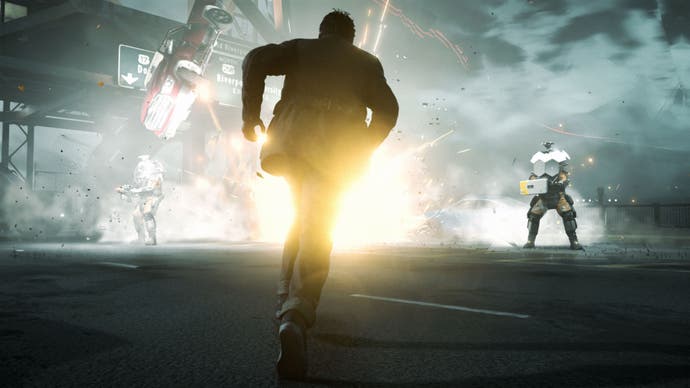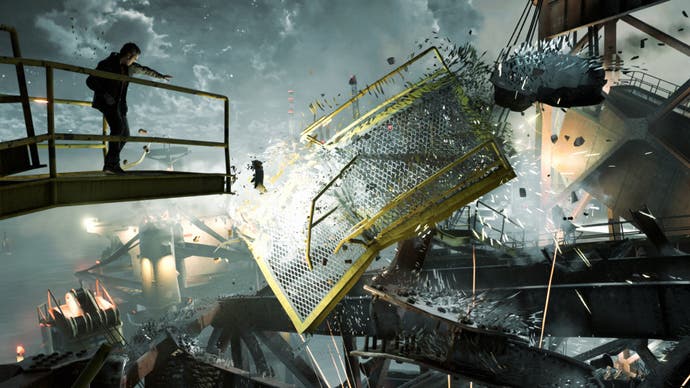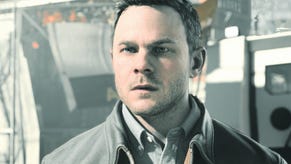Is there more to Quantum Break than run-of-the-mill third-person shooting?
Time will tell.
You've seen the gameplay demo: Jack Joyce, the nondescript every-man hero of Xbox One exclusive Quantum Break, fights evil corporation goons in what looks like run-of-the-mill third-person cover shooting, made ever-so-slightly different by a dash of clichéd time powers and the odd exploding car. Slow down time to escape, throw a time bubble to catch bullets, rush enemies for a takedown, that sort of thing. Sure, the next game from Remedy, the team behind Max Payne and Alan Wake, looks pretty enough, but the action - what we've seen of it, anyway - just looks sort of okay.
But during a behind-closed-doors presentation at Gamescom last week, creative director Sam Lake extended the gameplay demo with a 19-minute playthrough that suggested there's more to Quantum Break than what we'd seen during Microsoft's Gamescom press conference - and it's this stuff that has piqued my interest.
After the on-stage demo ends, Jack needs to navigate the collapsing bridge - get from A to B, essentially - in a linear fashion. What makes this journey interesting is that the entire area is caught in what Remedy calls a time stutter, and within that stutter, pockets of time are breaking apart. Timelines for objects, some as big as trucks, are caught in destructive loops, so shift back and forth. Jack uses his time powers to temporarily slow down these objects, then must quickly run forward before they start moving again. There are a few leaps of faith, platform jumps that Jack just about makes. It's old-school 3D platforming, in a way.
The section we're shown, of a bridge being destroyed by an errant cargo ship that has crashed into it, is incredibly detailed. It looks as if Remedy has actually mapped out how the parts of the bridge would react to having a ship smash into it, then cherry-picked from the wreckage parts to jerk in and out of time. It's all an illusion, of course, but a compelling one. The crashing of concrete and twisting of metal is spectacular to watch and, because of the constant looping back and forth, it has an odd, hypnotic quality to it.
So, Quantum Break involves platforming. But what else? Here's where the "entertainment experience" part of the game comes in. Lake calls Quantum Break "a fusion of a cinematic action game and a top-of-the-line live-action show". Both ship on the same disc. Here's how that works.
Quantum Break, the game, is about heroes such as Jack. The show is about villains. Lake calls the show an "edgy, modern TV series" in which you follow the schemes and power plays inside Monarch Solutions, the big bad corporation behind the time collapse at the fictional east coast university town of Riverport.
Each act of the game ends with a "junction in time", and here you get to play the bad guy, Paul Serene. This is Remedy's interactive take on the classic action-movie scene where we see the bad guy plotting and scheming. Serene has the most powerful time power of all: the ability to see visions of different potential futures. When you play as him you explore and investigate two of these glimpses and then make a decision about which comes to pass. Then you watch an episode of the show that reflects that decision. "For the show we are shooting alternate scenes, and depending on your choice you will get your own version of the show," Lake explains. "Watching the show, you will see certain things that will feed back to the next act of the game and give you an advantage."
Will it work? It's hard to tell right now, but Jack comes across as such an uninteresting character that I'm looking forward to playing the bad guy, Paul Serene, in the hope he's got more going on. Whatever your take on the whole TV, TV, TV thing Microsoft trumpeted ahead of the launch of the Xbox One, at least the way TV works with Quantum Break makes for something a little different. And, at the end of the day, if you don't like the show you can skip it, although Lake says playing the game and watching the show is the "optimal experience".
"It's the extension of the same thing as in a story-driven game where the player is free to skip all the cinematics if they want," he says. "They will be missing out and not experiencing the full experience. It's up to the player. It's an interactive experience and that's how it should be."

I keep coming back to concern over the combat, though, in the absence of more information about the story (Remedy is going against its own grain here and talking less about Quantum Break's story than it tended to do with its previous games). What I've seen of the shooting fails to inspire, but Remedy promises that as players progress through the game, fighting enemies will get a lot more interesting.
When the game begins, Jack's time powers are limited and, for the player, easy to learn. They're all governed by the same energy meter that regenerates over time (the gameplay demo regenerates energy a lot quicker than it will in the final version of the game, Remedy notes). The time rush move we see in the gameplay video, which lets you get close to enemies for a takedown, starts as a time dodge designed to help you escape tricky situations. But during the demo, which is lifted from the middle of the game, Jack can use this dodge move for a longer period of time so it can be used as the time rush.
Another example: Jack's time stop power, which we see him almost fire out of his hands as a bubble. This starts as something that affects a single character. But later in the game Jack gains more control over it, so can aim the bubble where he wants and increase its size, turning it into a sort of area-of-effect spell.
All the powers progress in this way as you play, but there's no tech tree. Powers evolve and unlock according to the pacing set out by Remedy. "In one part, Quantum Break is a superhero origin story," Lake says. "Jack is that hero and his powers start to manifest and he is learning to use them as the player is learning to use them."
And the combat set-ups get more complicated, too. At the end of the gameplay demo, Jack goes up against two heavy-duty Monarch enemies who use technology to operate inside time stutters. The combat here only gets interesting when Jack sends a car speeding towards them (one of his powers is the ability to add momentum to objects that are frozen in time). Later, time stutters will have a lot more going on, with timelines similar to those we saw in the platforming section causing objects to violently loop within the environment.
"In stutter combat, there are always unique aspects, like things you can destroy or cars you can shoot," Lake explains. "The stutter in its calmer state attempts to always go back to its original state. So if you shoot at the car, it explodes, that explosion freezes, it does damage to anyone close by, but then after a moment it rewinds back to its original state. So in that sense there are tools and dangers that can be used multiple times in the stutter because it's always going back and forth."

The nature of publisher press conferences means developers have only a handful of minutes to show off their games, and for Remedy and Quantum Break it was no exception. Like so many developers before it, the Finnish studio picked a sequence it felt would entertain as much as inform. But the end result was, for me, pretty forgettable.
It was the extended presentation that revived my interest in Remedy's latest effort. I still have concerns - like, what's quantum about Quantum Break? - and Jack, bless him, just isn't doing anything for me at all. But I know this: there's a lot more to the game than third-person shooting. Will it all come together in the way I hope? Time will tell.














.png?width=291&height=164&fit=crop&quality=80&format=jpg&auto=webp)



